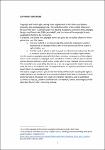HOW DO FOLLOWERS EXPERIENCE SHARED LEADERSHIP AS A LIVED EXPERIENCE? Understanding the relationality, processes and practices informing such collaboration.
| dc.contributor.supervisor | PHIPPEN, ANDY | |
| dc.contributor.author | SCHIFFMANN, SYBILLE ERIKA | |
| dc.contributor.other | PLYMOUTH BUSINESS SCHOOL | en_US |
| dc.date.accessioned | 2024-01-24T12:56:07Z | |
| dc.date.available | 2024-01-24T12:56:07Z | |
| dc.date.issued | 2024 | |
| dc.identifier | 920211 | en_US |
| dc.identifier.uri | https://pearl.plymouth.ac.uk/handle/10026.1/21963 | |
| dc.description.abstract |
How do followers experience shared leadership as a lived experience? Understanding the relationality, processes and practices informing such collaboration. Within shared leadership research culture, the aspiration is to explore “leadership as a dynamic interactive influence process”’ at the group level, supporting goal achievement (Pearce and Conger, 2003, P.1). However, the motivation of much research has focused on performance improvement, whereby discrete leadership variables are examined, using reductionist methods, to determine relevant linkages to team effectiveness (Denis et al., 2012. See also Fairhurst et.al, 2020). In expanding understanding of shared leadership from a follower perspective, enabling a fuller appreciation of how that has been experienced and operationalised over time, an immersive, participatory action research study was conducted, to facilitate a processual view of shared leadership; one that embraces relational aspects of shared leadership and considers its dynamic emergence within a hierarchical leadership setting. Unconventionally, Relational Cultural Theory has been applied to enable a more meaningful and nuanced consideration of this leadership phenomenon (Fletcher, 2012). This expanded consideration of shared leadership has produced four main findings: • The follower “voice” has been meaningfully expressed regarding experiences and actions, occurring throughout such collaboration. • A more processual understanding of the shared leadership undertaking itself, reveals how the cultivation of interdependence enables the dynamic operationalisation of expertise in relational and reciprocal ways. • The shifting nature of power dynamics has been explicated, as well as recognising the degree of interdependence occurring between followers and their leaders. • Learning History methodology was innovatively applied to facilitate a more processual understanding of shared leadership, facilitating new theoretical and practical understanding. This study challenges some of the negative connotations that may surround conceptualisations of followers and followership (Uhl-Bien, 2018), as well as actively elevating and emotionalising their experience, which is uncommon (Reitz, 2014). Finally, this study, through its positive conceptualisation of share leadership effectively challenges the myth of individual achievement that pervades much organisational life (Miller, 2012). | en_US |
| dc.language.iso | en | |
| dc.publisher | University of Plymouth | |
| dc.rights | Attribution-NonCommercial-NoDerivs 3.0 United States | * |
| dc.rights.uri | http://creativecommons.org/licenses/by-nc-nd/3.0/us/ | * |
| dc.subject | Shared leadership, followership, collective leadership, relational cultural theory, learning history. | en_US |
| dc.subject.classification | PhD | en_US |
| dc.title | HOW DO FOLLOWERS EXPERIENCE SHARED LEADERSHIP AS A LIVED EXPERIENCE? Understanding the relationality, processes and practices informing such collaboration. | en_US |
| dc.type | Thesis | |
| plymouth.version | publishable | en_US |
| dc.identifier.doi | http://dx.doi.org/10.24382/5137 | |
| dc.identifier.doi | http://dx.doi.org/10.24382/5137 | |
| dc.rights.embargoperiod | No embargo | en_US |
| dc.type.qualification | Doctorate | en_US |
| rioxxterms.version | NA |
Files in this item
This item appears in the following Collection(s)
-
01 Research Theses Main Collection
Research Theses Main



